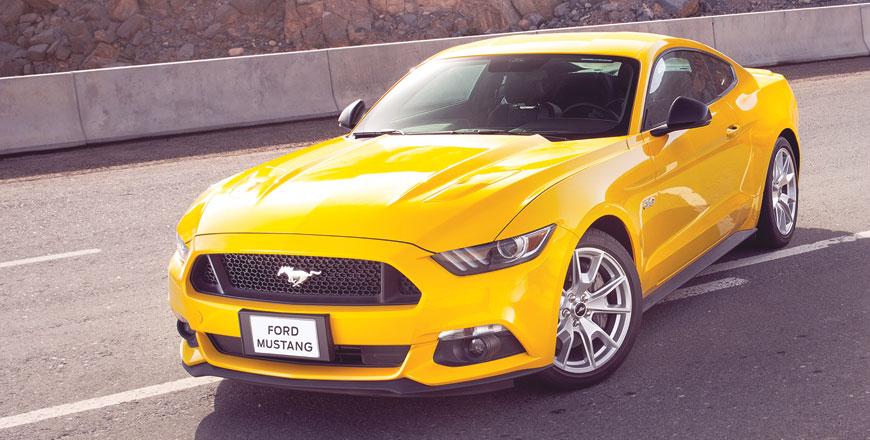You are here
Ford Mustang 2.3 EcoBoost: Attainable icon
By Ghaith Madadha - Dec 14,2015 - Last updated at Dec 14,2015

Photo courtesy of Ford
Winner of the 2015 Middle East Car of the Year Award, the latest generation of Ford’s attainable icon, the new Mustang is the most advanced, efficient, refined and sportiest yet. Brimming with feel-good charm, from distinctive acoustics to evocatively evolutionary design, the viscerally charged new Mustang’s biggest changes are under its skin.
The first Mustang factory-fitted with independent rear suspension and first powered by a four-cylinder engine since 1978-87, the new model is aimed at US and global markets, including Europe for the first time. Slotting in between 3.7-litre V6 and 5-litre V8 versions, the new turbocharged Mustang 2.3-litre EcoBoost driven is muscularly efficient, and boasts power comparable to 2005-09 4.6-litre V8 predecessors.
Nostalgic yet contemporary
Arriving to coincide with the classic nameplate’s 50th anniversary, the all-new Mustang features a more contemporary interpretation of the original American muscle car. Not deviating far from predecessors’ hallmark long bonnet, fastback roofline, recessed headlights, vertical tri-bar rear lights, the new Mustang, however, has a moodier more urgent demeanour and viscerally athletic posture, and LED lighting elements.
Harmoniously retaining classic design cues but seamlessly integrated with Ford’s current family design themes, the new Mustang is influenced by the 2011 Evos concept’s wide hexagonal grille and deep-set, squinting and heavily bowed headlights. And with long, high bonnet with distinctive dual centre scallops, it looks snoutier and more aggressive, with a palpably sense of dynamic urgency.
Wider and with more prominent profile curves, pinched hips, more sculpted surfacing and ridges, and better integrated more flowing fastback and rear deck, the new Mustang projects more power, presence and prestige. Nostalgic yet contemporary it features circular vents, meaty three-spoke steering wheel, big round dials, four-gang gated driving mode toggle switches and plenty of chrome-effect trim inside.
A small brute
Inevitable, welcome and necessary for contemporary customer and legislative efficiency considerations, the Mustang 2.3-litre turbocharged four-cylinder EcoBoost is especially relevant in Europe and markets like Jordan. A high output and efficiency unit, the four-pot EcoBoost develops 310BHP at 5500rpm and generous 320lb/ft torque throughout a broad and versatile 2500-4500rpm band for effortless overtaking, it can also return frugal 8l/100km fuel efficiency.
Dispatching 0-100km/h in a swift 5.8 seconds and capable of 240km/h at full tilt, the Mustang 2.3 EcoBoost is a compact brute with quick-spooling turbo, that all but eliminates low-end turbo lag and pulls meaningfully and smoothly from tick-over. Underwritten by generously broad torque peak, power wells to its 5500rpm peak, before an up-shift again summons the Mustang’s brawny and versatile mid-range.
Designed to perform like a V6 engine, the EcoBoost is however at its best when riding its rich, muscular and generously flat peak torque band, where it noticeably hardens by 2500rpm and feels like a previous generation V8. Such an impression is aided by somewhat low-revving characteristics and gurgling and growling intake acoustics piped through the cabin for dramatic effect.
Committed and charismatic
Despite small pockets of archaic-minded naysayers among the muscle car faithful — the new Mustang’s adoption of more sophisticated rear independent — rather than live axle — suspension is welcome and modernising change. With independent rear integral-link suspension and improved body rigidity for better suspension and steering precision, the new Mustang delivers noticeably enhanced handling, ride and cabin refinement.
Smoother, more settled and comfortable than predecessors, the new Mustang’s independent rear wheel travel provides fluency over imperfections and settled, buttoned down rebound control over crests and dips. Firm but forgiving the Mustang’s 255/40R19 tyres generate high grip levels on turn-in and through corners. Slightly stiff over sharp sudden speed bumps the Mustang nonetheless comfortably smooth, with taut body control through corners.
Tidy turning-in the Mustang’s steering features adjustable weighting. Stability control and engine throttle gearbox responses can also be tailored for sporty driving or comfort. Well-balanced with intuitive on throttle adjustability, the Mustang’s handling is agile and after settling into a corner, is highly committed throughout. With wide track, rear wheels tenaciously dig in as one reapplies the throttle to blast onto a straight.
Visceral and visible
Stable at speed, the Mustang rides with heavy and firmly planted feel, while sat hunkered down, its long bonnet features dual scallops to help place it on road and create a muscle car ambiance. Ergonomic and accessible, with well-adjustable driving position, the Mustang’s well-padded front seats comfortably accommodate larger taller occupants, but stiffer side bolstering would help match its high lateral grip.
Airier and with better visibility than chief rivals, the Mustang’s generous 385-litre boot and useably-sized — if not hugely spacious — rear seats prove usefully practical for a 2-door sports coupe. Using mostly good quality plastics and soft textures, its cabin feels more up-market, and with Premium guise, as tested, features heated and cooled seats, dual-zone climate control, ambient lighting and 50 Years Anniversary decals
Well-equipped, the Mustang EcoBoost features an intuitive Sync infotainment system with voice-activated connectivity, 8-inch touchscreen and 9 speakers. Safety kit includes eight airbags, childseat latches and optional driver assistance systems including adaptive cruise control and blindspot and cross traffic assists. An optional performance package with limited-slip rear differential, stiffer anti-roll bars and firmer damping provides enhanced cornering ability, agility and control over mid-corner road imperfections.
TECHNICAL SPECIFICATIONS
Engine: 2.3-litre, all-aluminium, turbocharged, in-line 4 cylinders
Bore x stroke: 87.55 x 94mm
Compression ratio: 9.5:1
Valve-train: 16-valve, DOHC, variable valve timing, direct injection
Gearbox: 6-speed automatic, rear-wheel drive, limited-slip differential
Gear ratios: 1st 4.17:1; 2nd 2.34:1; 3rd 1.52:1; 4th 1.14:1; 5th 0.87:1; 6th 0.69:1
Final drive ratio: 3.15:1
Power, BHP (PS) [kW]: 310 (314) [231] @5500rpm
Specific power: 137.1BHP/litre
Power-to-weight: 194BHP/tonne
Torque, lb/ft (Nm): 320 (434) @2500-4500rpm
Specific torque: 170.1Nm/litre
Torque-to-weight: 191.9Nm/tonne
0-100km/h: 5.8 seconds (est.)
Top speed: 240km/h (est.)
Fuel consumption: 8l/100km
CO2 emissions: 179g/km
Length: 4782mm
Width: 1915mm
Height: 1381mm
Wheelbase: 2720mm
Track, F/R: 1582/1648mm
Aerodynamic drag co-efficient: 0.328
Headroom, F/R: 955/883mm
Legroom, F/R: 1130/777mm
Shoulder room, F/R: 1430/1325mm
Luggage volume: 382 litres
Fuel capacity: 60 litres
Kerb weight: 1598kg
Weight distribution, F/R: 52 per cent/48 per cent
Steering: Electric-assisted rack & pinion
Turning circle: 11.5 metres
Suspension, F/R: MacPherson Struts/integral link, anti-roll bars
Brakes, F/R: Ventilated discs, 320mm/discs, 320mm
Brake callipers, F/R: Twin/single
Tyres: 255/40R19
Related Articles
America’s most celebrated car, the Ford Mustang was first launched in 1964 and is credited with creating the affordable, accessible and visc
The original muscle when appearing in 1964 and first to resurrect such cars in 2005, the iconic trend-setting Ford Mustang made stylish two-
Among the most evocative and honest of all car segments with its emphasis on undiluted thrills, aggressive designs, feelgood flavours and vi


















